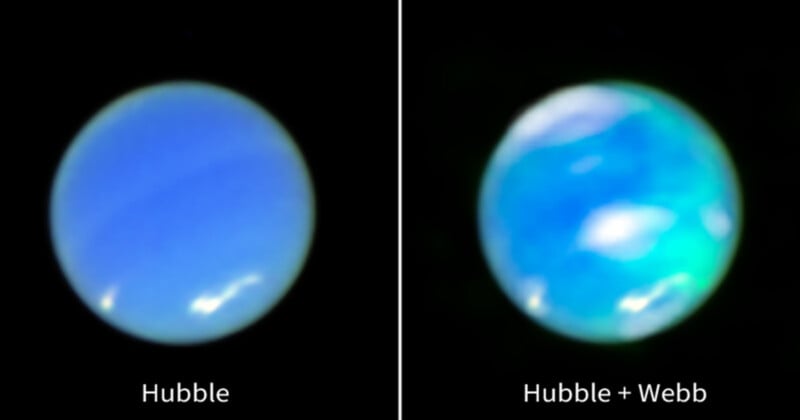Auroras on Neptune Captured on Camera for First Time
![]()
NASA’s James Webb Space Telescope (JWST) captured images of auroral activity on Neptune for the first time.
Much like auroras in Earth’s atmosphere, the vibrant displays above Neptune’s icy surface are due to energetic particles from the Sun interacting with Neptune’s upper atmosphere, trapped in place by the planet’s magnetic field.
While astronomers have seen hints of auroral activity on Neptune over the years, including during NASA’s Voyager 2 flyby in 1989, imaging had long proven evasive. Astronomers had successfully documented auroras on Jupiter, Saturn, and Uranus over the years, but never Neptune.
Ultimately, it was Webb’s impressive near-infrared sensitivity that saved the day.
“Turns out, actually imaging the auroral activity on Neptune was only possible with Webb’s near-infrared sensitivity,” says Henrik Melin of Northumbria University, lead author of a new research paper. Melin conducted his research while at the University of Leicester in England. “It was so stunning to not just see the auroras, but the detail and clarity of the signature really shocked me.”
Melin and his team’s results were published in last week’s issue of Nature. They gathered the necessary data in June 2023 using Webb’s Near-Infrared Spectrograph. Beyond capturing images of Neptune, they also obtained spectral analysis of the planet’s surface to characterize its composition and measure the upper atmosphere’s temperature.

Inside Neptune’s upper atmosphere, the researchers located the trihydrogen cation H3+, which can be an essential ingredient for auroras.
“H3+ has a been a clear signifier on all the gas giants — Jupiter, Saturn, and Uranus — of auroral activity, and we expected to see the same on Neptune as we investigated the planet over the years with the best ground-based facilities available,” explains Heidi Hammel of the Association of Universities for Research in Astronomy, Webb interdisciplinary scientist and leader of the Guaranteed Time Observation program for the Solar System in which the data were obtained. “Only with a machine like Webb have we finally gotten that confirmation.”
Although the mechanism by which auroras form on Neptune is familiar, the activity itself is bizarre. Unlike auroras on Earth, which occur primarily near the planet’s northern and southern poles, the activity on Neptune is located near mid-latitudes, similar to where South America is located on Earth.
The unusual auroral location on Neptune is due to the planet’s strange magnetic fields. As Voyager 2 observed in 1989, Neptune’s magnetic field is tilted 47 degrees from the planet’s rotation axis.
“Since auroral activity is based where the magnetic fields converge into the planet’s atmosphere, Neptune’s auroras are far from its rotational poles,” NASA explains.
Beyond Webb’s near-infrared sensitivity playing a key role in this long-awaited discovery of auroras on Neptune, the scientists also found something else that could have contributed to the auroras being so evasive.
Astronomers have predicted that the intensity of Neptune’s auroras would relate to the temperature of Neptune’s upper atmosphere, where a warmer atmosphere would result in stronger and more powerful auroral displays. In the roughly 36 years since Voyager 2’s flyby of Neptune, the planet’s upper atmosphere has cooled by hundreds of degrees.
“I was astonished — Neptune’s upper atmosphere has cooled by several hundreds of degrees,” Melin says. “In fact, the temperature in 2023 was just over half of that in 1989.”
Scientists believe this increasingly cool temperature has played a key role in keeping “much fainter auroras” hidden from sight for so long.
“As we look ahead and dream of future missions to Uranus and Neptune, we now know how important it will be to have instruments tuned to the wavelengths of infrared light to continue to study the auroras,” concludes Leigh Fletcher of Leicester University, a co-author on the paper. “This observatory has finally opened the window onto this last, previously hidden ionosphere of the giant planets.”
Image credits: NASA, ESA, CSA, STScI, Heidi Hammel (AURA), Henrik Melin (Northumbria University), Leigh Fletcher (University of Leicester), Stefanie Milam (NASA-GSFC)